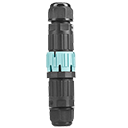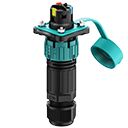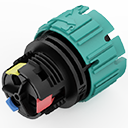In the world of photovoltaic (PV) connectors, it is important to understand which connector is positive and which is negative in order to properly connect solar panels and ensure optimal performance. The positive and negative terminals in PV connectors are typically designated by different colors or symbols to make it easier for installers to identify and correctly make the connections.
To correctly identify the positive and negative terminals in PV connectors, it is essential to refer to the manufacturer’s instructions or specifications for each type of connector. In addition, it is always a good idea to double-check the connections before finalizing the installation to avoid any potential issues or malfunctions.
When connecting PV connectors, it is important to follow best practices to ensure a secure and reliable connection. This includes making sure that the connectors are properly aligned and securely fastened, as well as using the appropriate tools and equipment for the job.
By understanding which PV connector is positive and following proper installation procedures, installers can help ensure that solar panels operate efficiently and effectively, maximizing the benefits of renewable energy technology.
In PV connectors, the terms positive and negative refer to the polarity of the electrical current flowing through the system. The positive terminal carries the current from the solar panels to the inverter, while the negative terminal returns the current back to the panels.
It is essential to correctly identify the positive and negative terminals in PV connectors to ensure the system operates efficiently and safely. Connecting the terminals incorrectly can lead to a decrease in energy production and even damage to the components.
Most PV connectors are designed with specific markings or colors to indicate the positive and negative terminals. For example, the positive terminal is often marked with a red color or a plus sign, while the negative terminal is marked with a black color or a minus sign.
When connecting PV connectors, it is essential to follow best practices to ensure a reliable and safe connection. This includes making sure the connectors are clean and free of dust or debris, using the appropriate tools to tighten the connections, and ensuring that the terminals are securely fastened.
Best Practices for Connecting PV Connectors: When connecting PV connectors, there are some best practices to follow to ensure a secure and reliable connection. It is important to make sure that the connectors are properly aligned and securely fastened to prevent any loose connections. Additionally, it is recommended to use the appropriate tools and equipment for the job to avoid any damage to the connectors. Regular maintenance and inspection of the connectors should also be conducted to ensure they are in good working condition. By following these best practices, you can ensure the optimal performance and longevity of your solar system.
When working with MC4 connectors, it is important to understand which terminal is positive and which is negative. The positive terminal is typically identified by a “+” sign, while the negative terminal is identified by a “-” sign. It is crucial to connect the positive terminal of one connector to the negative terminal of another to ensure proper electrical flow.
To connect MC4 connectors, it is recommended to follow best practices to ensure a secure and reliable connection. This includes properly stripping the wire, crimping the connector securely, and using a sealing gel to protect the connection from moisture and corrosion.
In PV connectors, it is crucial to correctly identify the positive and negative terminals to ensure proper connection and safe operation of the solar panels. The positive terminal is typically indicated by a red color or a plus sign, while the negative terminal is indicated by a black color or a minus sign. It is important to follow the manufacturer’s instructions and markings on the connectors to avoid any confusion.
To ensure proper identification of the positive and negative terminals in PV connectors, always refer to the manufacturer’s documentation and follow best practices for connecting the connectors. This includes making sure the connectors are securely plugged in, using proper tools for installation, and double-checking the polarity before connecting the solar panels to the rest of the system. By correctly identifying and connecting the positive and negative terminals in PV connectors, you can ensure optimal performance and longevity of your solar PV system.
Best Practices for Connecting PV Connectors
When working with PV connectors, it is important to follow some best practices to ensure a safe and reliable connection. Here are some tips to keep in mind:
1. Check the polarity: Before connecting PV connectors, always double-check the polarity to make sure you are connecting the positive terminal to the positive terminal and the negative terminal to the negative terminal. This will prevent any potential damage to the system.
2. Use the right tools: Make sure you are using the correct tools for connecting PV connectors. This includes crimping tools, stripping tools, and torque wrenches. Using the right tools will help ensure a secure and tight connection.
3. Inspect the connectors: Before making any connections, inspect the PV connectors for any damage or wear. If you notice any issues, such as corrosion or loose connections, replace the connectors before proceeding.
4. Follow manufacturer guidelines: Always refer to the manufacturer’s guidelines for connecting PV connectors. Each type of connector may have specific instructions for installation, so make sure to follow them closely.
5. Use proper cable management: When connecting PV connectors, make sure to properly manage the cables to prevent any strain or damage. Use cable clips or ties to secure the cables in place and prevent any potential hazards.
6. Test the connection: After making the connections, perform a continuity test to ensure that the connections are secure and there are no loose wires. This will help prevent any future issues with the system.
By following these best practices for connecting PV connectors, you can ensure a safe and reliable connection that will help maximize the performance of your PV system.











9.jpg)

0 Comments